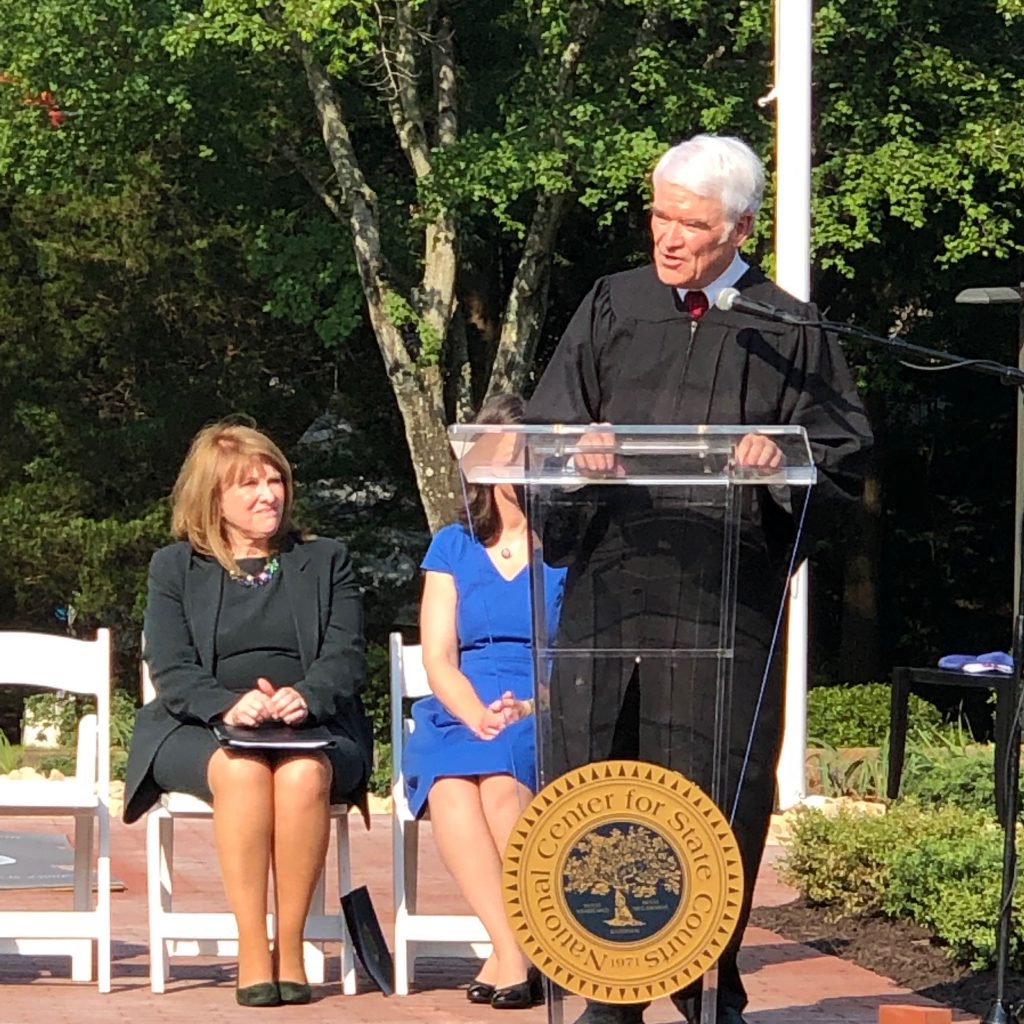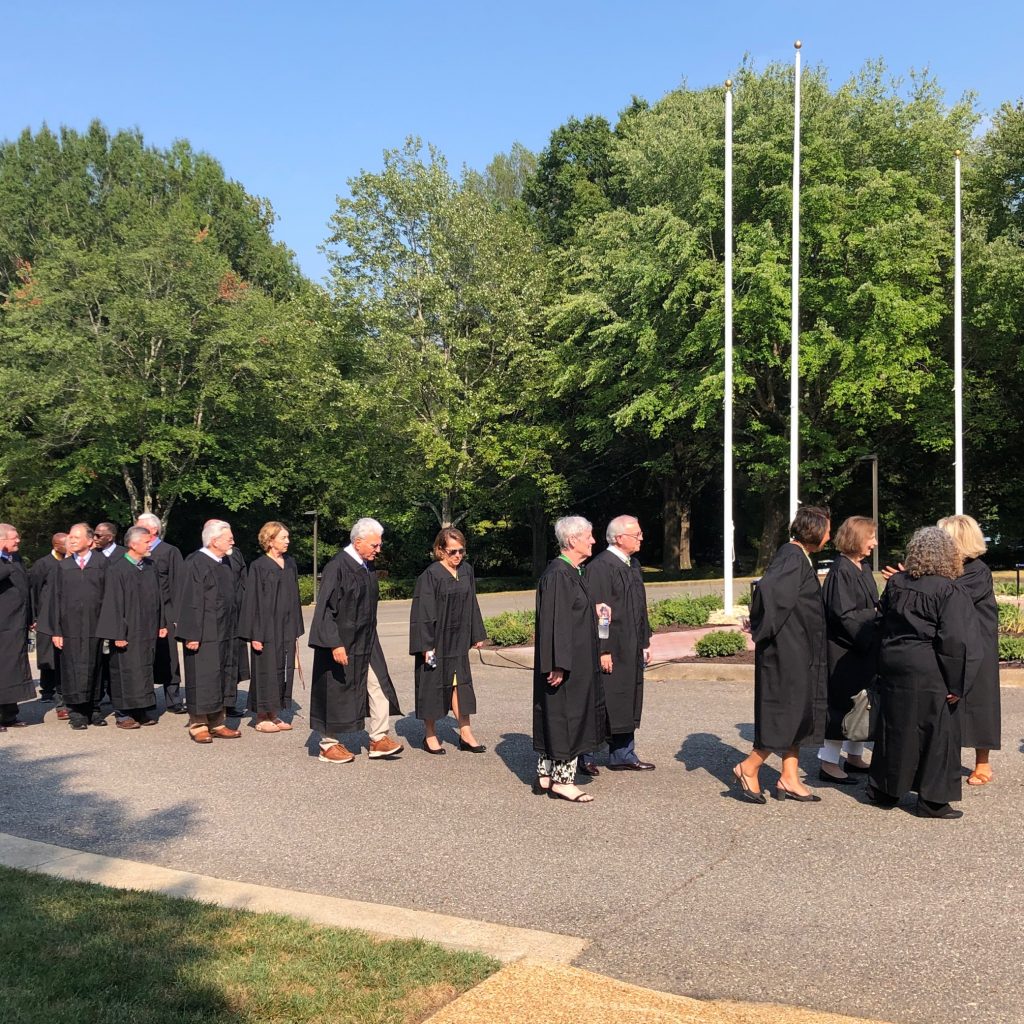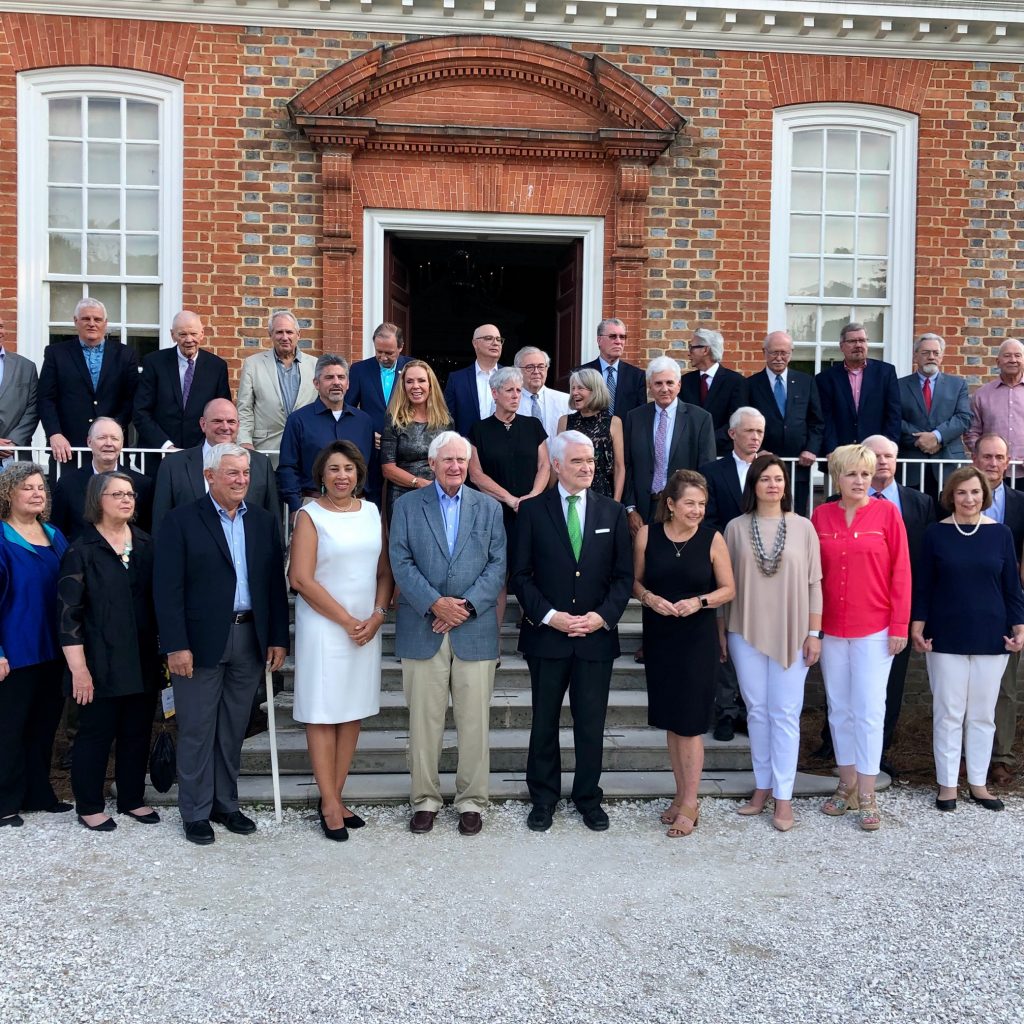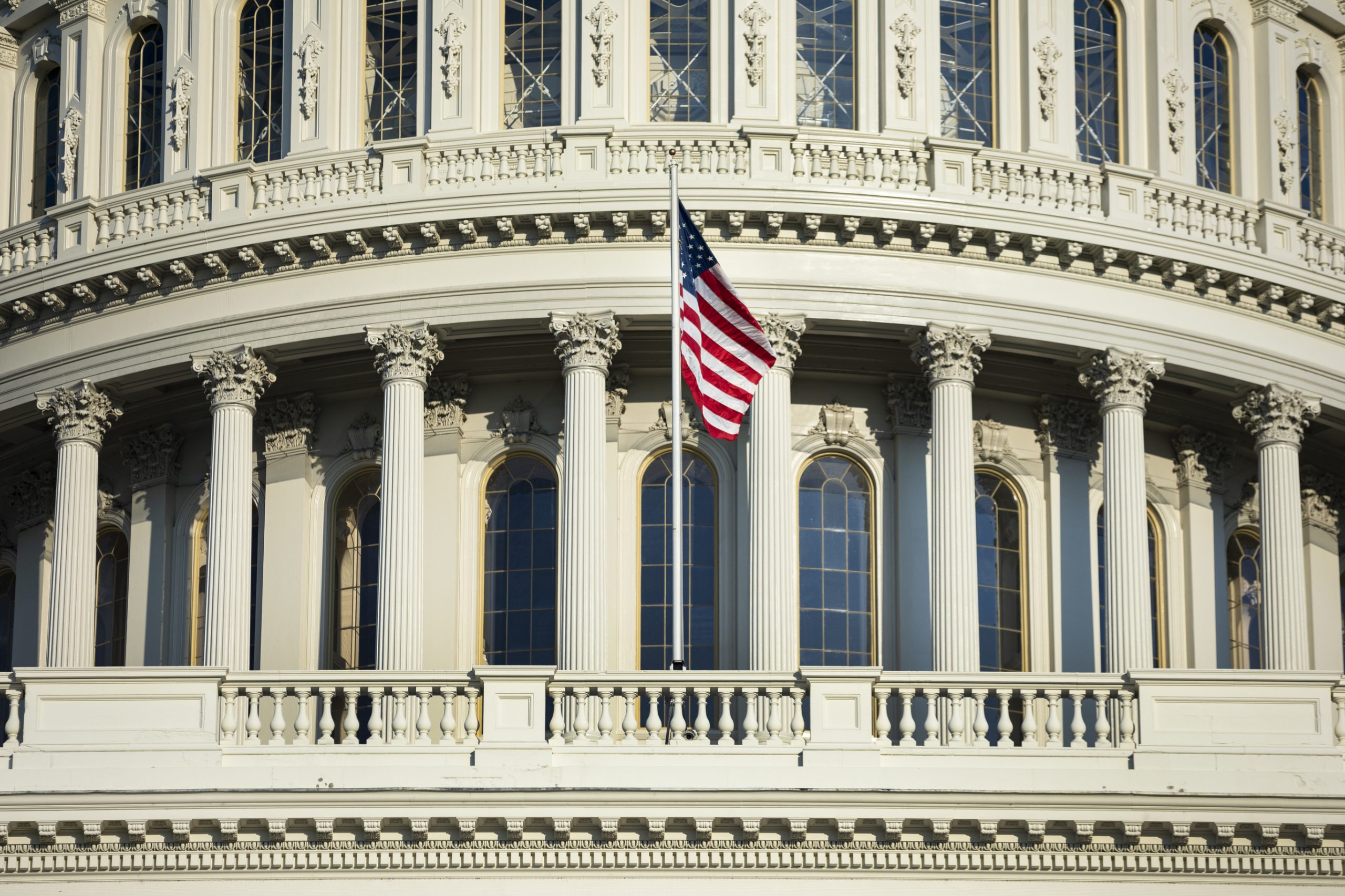The NASTD Annual Conference and Technology Showcase explored topics including cybersecurity, public-private partnerships, automation and artificial intelligence, state IT responses to the pandemic and much more.
Continue readingAssociates in Action: LifePoint Health Helps Expand Access to COVID-19 Vaccines in Tennessee
LifePoint Health, a CSG Associate, partnered with the Tennessee Department of Health to host two COVID-19 vaccination clinics for Special Olympics Tennessee.
Continue readingOpioid Litigation Settlement: Using Evidence to Lead Action
The Office of National Drug Control Policy has released the following information:
Opioid Litigation Settlement: Using Evidence to Lead Action
Monday, August 30 12:30p – 5:00p EST
via Zoom
The Office of National Drug Control Policy will host a half-day virtual convening for the nation’s state, local and tribal government leaders to share best practices on the use of forthcoming opioid litigation settlement funds.
At this convening, attendees will hear from leaders in the Federal government, the states, academia and community organizations about:
- Principles to guide decision-making about the use of the funding;
- Information from the Federal government on the abatement process;
- Tools for assessing community needs and concerns related to substance use disorder and overdose; and
- Best practices for collaboration between service providers and State, local, and Tribal governments to deliver evidence-based care and services.
The event is open to all state, local and tribal members of your association, with ample time for questions and discussion throughout the day.
An invitation with Zoom link will follow, and we look forward to a productive conversation with you and your Association’s membership.
Learn more about the opioid settlement:
What States Need to Know: State Attorneys General Reach Agreement on $26 Billion Opioid Settlement
In late July, a bipartisan group of attorneys general and local government lawyers from 13 states endorsed a multi-billion-dollar settlement against major drug companies that would end several open civil lawsuits stemming from opioid distribution. The agreement would require three drug distributors and one drug maker to make $26 billion in payments to states and communities to provide, among other things, addition rehabilitation and prevention services.
Over the last several years, drug firms have faced a barrage of lawsuits for their alleged roles in encouraging the distribution and sale of opioids across the country at a time when drug addiction and opioid overdoses are on the rise. If the settlement is approved by the named states and municipalities — including California, Colorado, Connecticut, Delaware, Florida, Georgia, Louisiana, Massachusetts, New York, North Carolina, Ohio, Pennsylvania and Texas — thousands of lawsuits against the named companies would be dropped by states and cities.
States have a month from July 21 — when this agreement was first reached — to decide if they will accept the deal. Following this decision, states will contact counties and cities who will have 150 days to decide if they would like to be included in the suit and receive funds from the settlement. At least 44 states as well as 95% of cities, counties and others suing the companies and 90% of non-litigating jurisdictions must sign on to the deal to receive a portion of the money. In some states, the final call will rest with the attorney general, while others will require legislative approval.
Under the agreement, the three distributors — Cardinal Health, AmerisourceBergen and McKesson — would make $21 billion in payments over 18 years, while drug maker Johnson & Johnson would pay $5 billion over nine years. The exact amount of the payments to each state and city will be determined by the number of governments who sign on to the agreement and the population and impact of opioid addiction in each region.
According to The New York Times, a novel feature of this agreement is a provision that distributors establish an independent clearinghouse to track one another’s shipments, a new mechanism to make data more transparent and make it easier to know when oversized orders are placed.
A separate agreement between these four companies and Native American tribes is still being worked out. This settlement would only bind these four companies. Other suits against different drug manufacturers and distributors are still being processed.
The CSG Justice Center has resources available to states that are looking for evidence-based strategies to improve outcomes for people with substance abuse disorders. Additionally, the Justice Center also provides resources on best practices for successful reentry for people with opioid addictions and opioid addition screening and assessment for those in the criminal justice system.
Join the USDA and Stakeholders Including CSG National President Gov. Laura Kelly to Discuss Supply Chain Investment
Elected and appointed officials are invited to hear join the U.S. Department of Agriculture to discuss the $500 million Supply Chain Investment. USDA Secretary Tom Vilsack will be joined by key stakeholders including CSG National President, Kansas Gov. Laura Kelly, as well as Chief Geoffrey Standing Bear of the Osage Nation, Oregon Department of Agriculture Director Alexis Taylor and Renville County EDA Coordinator Jordan Zeller who will examine meat and poultry supply chain challenges in their states and communities.
To register for this webinar on Wednesday, Aug. 18 from Noon to 1 p.m. ET, visit: https://www.zoomgov.com/webinar/register/WN_PlxNdRsHQV2ack0NIv_eBQ. After registering, you will receive a confirmation email containing information about joining the webinar.
After the panel, there will be an opportunity for additional attendees to comment on how state, tribal and local governments can partner to leverage these USDA supply chain funds. To learn more: https://www.federalregister.gov/documents/2021/07/16/2021-15145/investments-and-opportunities-for-meat-and-poultry-processing-infrastructure.
What States Need to Know: State Attorneys General Reach Agreement on $26 Billion Opioid Settlement
By Bailey Pierce and Dakota Thomas
In late July, a bipartisan group of attorneys general and local government lawyers from 13 states endorsed a multi-billion-dollar settlement against major drug companies that would end several open civil lawsuits stemming from opioid distribution. The agreement would require three drug distributors and one drug maker to make $26 billion in payments to states and communities to provide, among other things, addition rehabilitation and prevention services.
Over the last several years, drug firms have faced a barrage of lawsuits for their alleged roles in encouraging the distribution and sale of opioids across the country at a time when drug addiction and opioid overdoses are on the rise. If the settlement is approved by the named states and municipalities — including California, Colorado, Connecticut, Delaware, Florida, Georgia, Louisiana, Massachusetts, New York, North Carolina, Ohio, Pennsylvania and Texas — thousands of lawsuits against the named companies would be dropped by states and cities.
States have a month from July 21 — when this agreement was first reached — to decide if they will accept the deal. Following this decision, states will contact counties and cities who will have 150 days to decide if they would like to be included in the suit and receive funds from the settlement. At least 44 states as well as 95% of cities, counties and others suing the companies and 90% of non-litigating jurisdictions must sign on to the deal to receive a portion of the money. In some states, the final call will rest with the attorney general, while others will require legislative approval.
Under the agreement, the three distributors — Cardinal Health, AmerisourceBergen and McKesson — would make $21 billion in payments over 18 years, while drug maker Johnson & Johnson would pay $5 billion over nine years. The exact amount of the payments to each state and city will be determined by the number of governments who sign on to the agreement and the population and impact of opioid addiction in each region.
According to The New York Times, a novel feature of this agreement is a provision that distributors establish an independent clearinghouse to track one another’s shipments, a new mechanism to make data more transparent and make it easier to know when oversized orders are placed.
A separate agreement between these four companies and Native American tribes is still being worked out. This settlement would only bind these four companies. Other suits against different drug manufacturers and distributors are still being processed.
The CSG Justice Center has resources available to states that are looking for evidence-based strategies to improve outcomes for people with substance abuse disorders. Additionally, the Justice Center also provides resources on best practices for successful reentry for people with opioid addictions and opioid addition screening and assessment for those in the criminal justice system.
New CSG Compacts Project Benefits Military Spouses
CSG partners with the Department of Defense to reduce workforce barriers for military spouses and other practitioners of licensed professions
—
How can the states reduce workforce barriers for military spouses and other practitioners of licensed professions?
That’s the question CSG is exploring through a competitive interstate compacts program in partnership with the U.S. Department of Defense (DOD). Following a competitive application process, CSG selected five professions to work with the CSG National Center for Interstate Compacts in developing model legislation that would help military spouses and other practitioners gain professional license portability through interstate compacts. The professions selected for compact assistance are cosmetology and barbering, dentistry and dental hygiene, massage therapy, social work and K-12 teaching.
Kicking off the project, CSG hosted a webinar series that brought together state leaders, subject matter experts and members of the professions to discuss the background and importance of this project. The final installment of the series on Aug. 24 at 2 p.m. (Eastern) will explore the Dentistry and Dental Hygiene Compact. (Click here to register).
Recordings of previous webinars are available on the CSG YouTube page:
Massage Therapy Compact Kickoff Meeting
Cosmetology and Barbering Compact Kickoff Meeting
Social Work Compact Kickoff Meeting
K-12 Teaching Compact Kickoff Meeting
Occupational licensure compacts create reciprocity between states while maintaining the quality and safety of services and protecting state sovereignty. Compacts result in a more efficient distribution of licensed workers by supporting practitioner mobility.
Prior to its partnership with the Department of Defense, the CSG National Center for Interstate Compacts led the development of interstate compacts for physicians, nurses, emergency medical services personnel, physical therapists, psychologists, occupational therapists, licensed professional counselors and audiologists/speech-language pathologists. More than 40 states and territories have adopted at least one of the compacts and over half have adopted three or more.
“Military spouses work hard to earn professional credentials and establish themselves in licensed occupations while also being willing to sacrifice their professional lives in support of their spouse so they can serve our country,” said Wisconsin state Sen. Joan Ballweg, who serves as the national chair for CSG. “Creating interstate compacts for these occupations will reduce regulatory burdens substantially and restore the career options they deserve. CSG and the Department of Defense chose worthy occupations, and I am encouraged by their progress on this vital project.”
State Chief Justices Gather for 50th Anniversary Celebration of the National Center for State Courts
The Chief Justices of the supreme courts of the states gathered at the National Center for State Courts at its headquarters in Williamsburg, Virginia. The Chief Justice of the Supreme Court of Texas and Chair of the Conference of Chief Justices and the National Center for State Courts, Nathan L. Hecht, delivered remarks at a celebration celebrating the organization’s 50th anniversary.
The State of State Capitol Security
by Patrick Edwards
The U.S. Capitol riot on Jan. 6 and subsequent threats have inspired a debate over capitol security in statehouses around the country. The events of January 6 are only one example of an already tumultuous year of political violence directed at public buildings and officials. The global pandemic also led to a need for additional security measures to protect against COVID-19. To better understand how these factors have impacted states, analysts with The Council of State Governments (CSG) performed a comprehensive scan of state capitol security across all 50 states and the District of Columbia.
CSG analysts found that significant policy differences exist between states on firearms permissions, security screenings and other security measures. Most capitols restrict the open and concealed carry of firearms and use both metal detectors and X-ray machines. However, seven statehouses permit both open and concealed carry and 13 use neither metal detectors nor X-ray machines.
Findings and Analysis
As of April 27, 2021, 28 state capitols and the Wilson Building (the Washington, D.C. capitol) are closed to the public. Of these 28 state capitols, 24 explicitly state that they are closed to prevent the spread of COVID-19. At the time of this analysis, information was not publicly available for the remaining four closed capitols. However, our analysis indicates that these four capitols are also likely closed due to COVID-19. Finally, the District of Columbia Wilson Building is closed because the city council is not in session. Notably, no state capitols are closed due to threats of violence. This stands in stark contrast to the weeks following Jan. 6 when at least 19 states deployed National Guard troops to their capitols and several shut down statehouse grounds in response to the U.S. Capitol riot.
States also implemented temporary increases in security measures following the U.S. Capitol riot but later removed these as threats of violence failed to materialize. Out of the 10 states that explicitly reported that areas around their capitols were inaccessible in early January, only two — Arizona and Washington — continue to do so. This may be an undercount, as information is not publicly available for 40 states.
Similarly, 10 state capitols explicitly reported that they employed security fencing. Three of these, Minnesota, Oregon and South Carolina, left their fencing installed. As above, this may be an undercount: these 10 states are those that reported setting up and removing their fences.
This indicates that the emphasis of capitol officials has shifted away from threats of political violence and back to the pandemic and traditional security.
34 states and Washington, D.C. prohibit the possession of firearms on capitol grounds, while 16 states permit the possession of personal firearms within their statehouses in some capacity. Citizens can use concealed carry in 14 of the 51 capitols (27%) and open carry in nine capitols (18%). Seven of the 14 capitols that permit concealed carry of firearms also allow open carry. Two states—Louisiana and Nebraska—permit open carry in their capitol complexes but prohibit concealed carry. Louisiana has no law restricting the open carry of firearms within its capitol. But while open carry is technically legal, online sources indicate that entering the capitol while brandishing a firearm will lead to arrest.
Most states prohibit the possession of firearms within their capitols, but a substantial minority do the opposite.
Another significant component of capitol security is the screening process — specifically, the use of metal detectors, X-rays, and required identification (ID).[1] Metal detectors are used to scan people (i.e., walk-through or handheld metal detectors. X-ray machines, however, scan personal items, packages, and the contents of each visitor’s pockets.
Thirty-seven capitols (37%, including the Washington D.C. city building) employ metal detectors at screening checkpoints in building entrances, and a further 31 capitols (61%), employ X-ray machines at entrances to scan all packages and personal items. Of the 18 state capitols that post their ID policy online, 10 required identification to enter their state houses.
Notably, a higher percentage of capitols that permit the open or concealed carry of firearms do not use metal detectors or X-rays compared to states that do not allow personal firearms on capitol grounds. 73% of all capitols use metal detectors, but only 50% of capitols that permit firearms use metal detectors. Similarly, 61% of all capitols use X-ray machines, but only 43% of capitols that allow personal firearms use X-ray machines. This suggests that states which permit personal firearms within their state houses may be less inclined to implement stronger security screening processes.
CSG identified several patterns between the law enforcement agencies that states entrust with protecting their capitol buildings. Twenty-one states delegate capitol security to capitol police divisions, and seven states delegate security to a division of the state’s highway patrol. Interestingly, Massachusetts delegates capitol security to park rangers in the state’s Department of Conservation and Recreation. All other states delegate security to unique subdivisions of each state’s primary police agency.
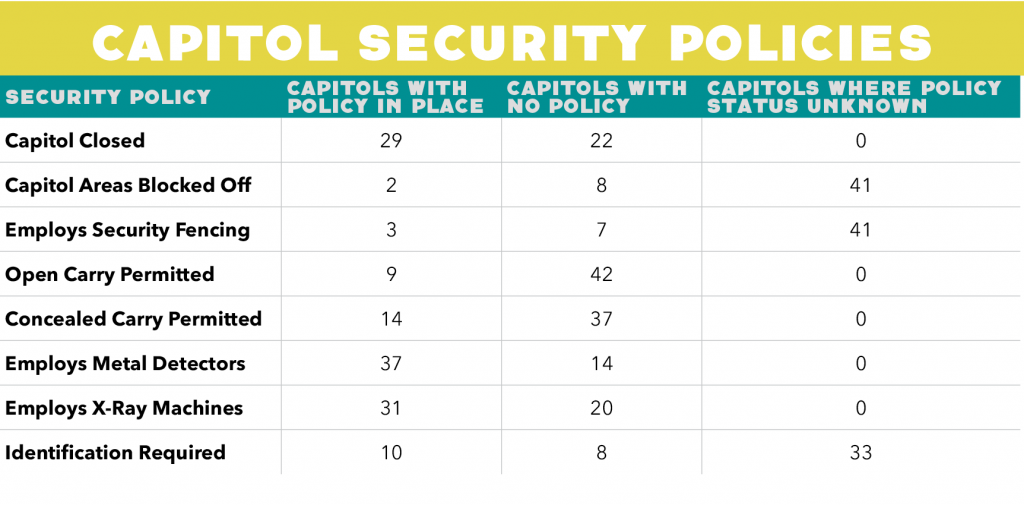
Method of Research
To conduct this research, CSG analysts gathered data from a variety of publicly available sources. Information on state capitol building firearm policy was primarily gathered from the Giffords Law Center’s Database of State Gun Laws and Michigan Advance’s Database of Capitol Building Firearm Policies. Most other data — including information on public access and security screening procedures —were gathered from statehouse websites or local news sources. This is not a comprehensive scan of all capitol security policies as some information is unavailable for most states. In particular, security measures like capitol fencing and ID requirements only reflect information that is publicly available online.
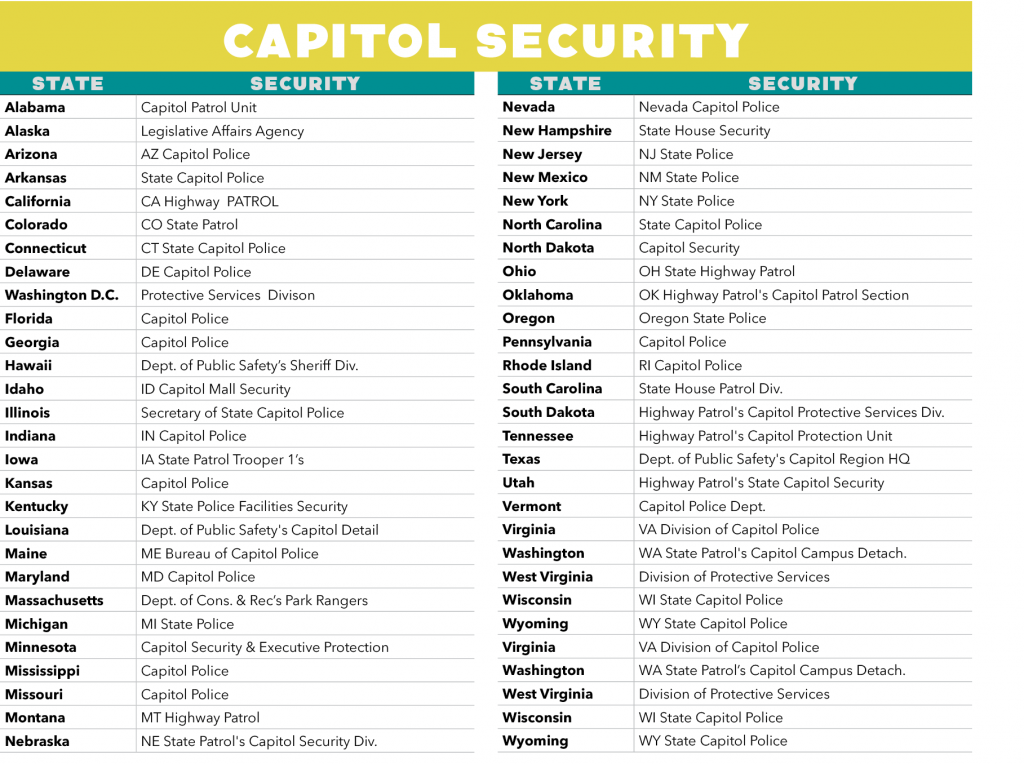




| State | Closed to public | Reason Closed | Areas Blocked | Open Carry | Conceal Carry | Metal Detectors | X-Ray Machines | Security Fencing | ID Required | Security | Date Collected |
|---|---|---|---|---|---|---|---|---|---|---|---|
| Alabama | 0 | N/A | 0 | 0 | 0 | 1 | 1 | ??? | ??? | Capitol Patrol Unit | 4/13/2021 |
| Alaska | 1 | COV-19 | ??? | 0 | 0 | 1 | 0 | 0 | 1 | Security: Legislative Affairs Agency | 4/13/2021 |
| Arizona | 1 | COV-19 | 1 | 0 | 0 | 1 | 1 | 0 | 0 | AZ Capitol Police | 4/15/2021 |
| Arkansas | 1 | COV-19 | 0 | 0 | 0 | 1 | 0 | 0 | 1 | State Capitol Police | 4/14/2021 |
| California | 1 | COV-19 | 0 | 0 | 0 | 1 | 1 | 0 | ??? | CA Highway Patrol | 4/15/2021 |
| Colorado | 0 | N/A | 0 | 0 | 0 | 1 | 1 | 0 | 0 | CO State Patrol | 4/13/2021 |
| Connecticut | 1 | COV-19 | 0 | 0 | 0 | 1 | 1 | ??? | 0 | CT State Capitol Police | 4/15/2021 |
| Delaware | 1 | COV-19 | ??? | 0 | 0 | 1 | 1 | ??? | 1 | DE Capitol Police | 4/15/2021 |
| Washington D.C. | 1 | Not Sess. | ??? | 0 | 0 | 1 | 1 | ??? | ??? | Protective Services Division | 4/15/2021 |
| Florida | 1 | COV-19 | ??? | 0 | 0 | 1 | 1 | ??? | ??? | Capitol Police | 4/15/2021 |
| Georgia | 0 | N/A | ??? | 0 | 0 | 1 | 1 | ??? | 1 | Capitol Police | 4/15/2021 |
| Hawaii | 1 | COV-19 | 0 | 0 | 0 | 0 | 0 | 0 | ??? | Dept. of Public Safety’s Sheriff Div. | 4/15/2021 |
| Idaho | 0 | N/A | 0 | 0 | 0 | 0 | 0 | ??? | ??? | ID Capitol Mall Security | 4/15/2021 |
| Illinois | 1 | COV-19 | ??? | 0 | 0 | 1 | 1 | ??? | ??? | Secretary of State Capitol Police | 4/15/2021 |
| Indiana | 0 | N/A | ??? | 0 | 0 | 1 | 1 | ??? | ??? | IN Capitol Police | 4/15/2021 |
| Iowa | 0 | N/A | ??? | 0 | 1 | 1 | 1 | ??? | ??? | IA State Patrol Trooper 1’s | 4/26/2021 |
| Kansas | 1 | COV-19 | ??? | 0 | 1 | 1 | 1 | ??? | 1 | Capitol Police | 4/20/2021 |
| Kentucky | 1 | COV-19 | ??? | 1 | 1 | 1 | 0 | ??? | 1 | KY State Police Facilities Security | 4/20/2021 |
| Louisiana | 0 | N/A | ??? | 1 | 0 | 1 | 1 | ??? | ??? | Dept. of Public Safety’s Capitol Detail | 4/20/2021 |
| Maine | 1 | COV-19 | ??? | 0 | 0 | 1 | 1 | ??? | ??? | ME Bureau of Capitol Police | 4/21/2021 |
| Maryland | 1 | COV-19 | ??? | 0 | 0 | 1 | 1 | ??? | 1 | MD Capitol Police | 4/21/2021 |
| Massachusetts | 1 | ??? | ??? | 0 | 0 | 1 | 0 | ??? | 0 | Dept. of Cons. & Rec’s Park Rangers | 4/20/2021 |
| Michigan | 0 | N/A | ??? | 0 | 0 | 0 | 0 | ??? | ??? | MI State Police | 4/20/2021 |
| Minnesota | 1 | ??? | ??? | 0 | 1 | 0 | 0 | 1 | ??? | Capitol Security & Executive Protection | 4/26/2021 |
| Mississippi | 0 | N/A | ??? | 0 | 0 | 1 | 1 | ??? | ??? | Capitol Police | 4/21/2021 |
| Missouri | 0 | N/A | ??? | 0 | 1 | 1 | 1 | ??? | 0 | Capitol Police | 4/21/2021 |
| Montana | 0 | N/A | ??? | 0 | 1 | 0 | 0 | ??? | ??? | MT Highway Patrol | 4/21.2021 |
| Nebraska | 0 | N/A | ??? | 1 | 0 | 0 | 0 | ??? | ??? | NE State Patrol’s Capitol Security Div. | 4/21/2021 |
| Nevada | 1 | COV-19 | ??? | 0 | 0 | 1 | 1 | ??? | ??? | Nevada Capitol Police | 4/21/2021 |
| New Hampshire | 0 | N/A | ??? | 1 | 1 | 0 | 0 | ??? | ??? | State House Security | 4/22/2021 |
| New Jersey | 1 | COV-19 | ??? | 0 | 0 | 1 | 1 | ??? | 1 | NJ State Police | 4/22/2021 |
| New Mexico | 1 | COV-19 | 0 | 1 | 1 | 0 | 0 | 0 | ??? | NM State Police | 4/22/2021 |
| New York | 1 | COV-19 | ??? | 0 | 0 | 1 | 1 | ??? | 1 | NY State Police | 4/22/2021 |
| North Carolina | 1 | COV-19 | ??? | 0 | 0 | 1 | 1 | ??? | ??? | State Capitol Police | 4/22/2021 |
| North Dakota | 0 | N/A | ??? | 0 | 0 | 1 | 1 | ??? | 0 | Capitol Security | 4/22/2021 |
| Ohio | 1 | N/A | ??? | 0 | 0 | 1 | 1 | ??? | 0 | OH State Highway Patrol | 4/22/2021 |
| Oklahoma | 0 | N/A | ??? | 0 | 0 | 1 | 1 | ??? | ??? | OK Highway Patrol’s Capitol Patrol Section | 4/23/2021 |
| Oregon | 1 | COV-19 | ??? | 1 | 1 | 0 | 0 | 1 | ??? | Oregon State Police | 4/23/2021 |
| Pennsylvania | 0 | N/A | ??? | 0 | 0 | 1 | 1 | ??? | ??? | Capitol Police | 4/22/2021 |
| Rhode Island | 1 | COV-19 | ??? | 0 | 1 | 1 | 1 | ??? | ??? | RI Capitol Police | 4/23/2021 |
| South Carolina | 0 | N/A | ??? | 0 | 0 | 1 | 0 | 1 | ??? | State House Patrol Div. | 4/23/2021 |
| South Dakota | 0 | ??? | ??? | 0 | 1 | 1 | 1 | ??? | 0 | Highway Patrol’s Capitol Protective Services Div. | 4/23/2021 |
| Tennessee | 0 | N/A | ??? | 0 | 0 | 1 | 1 | ??? | 1 | Highway Patrol’s Capitol Protection Unit | 4/23/2021 |
| Texas | 0 | N/A | ??? | 1 | 1 | 1 | 1 | ??? | ??? | Dept. of Public Safety’s Capitol Region HQ | 4/23/2021 |
| Utah | 0 | N/A | ??? | 1 | 1 | 0 | 0 | ??? | ??? | Highway Patrol’s State Capitol Security | 4/23/2021 |
| Vermont | 1 | COV-19 | ??? | 0 | 0 | 0 | 0 | ??? | ??? | Capitol Police Dept. | 4/23/2021 |
| Virginia | 1 | ??? | ??? | 0 | 0 | 1 | 0 | ??? | ??? | VA Division of Capitol Police | 4/23/2021 |
| Washington | 1 | COV-19 | 1 | 1 | 1 | 0 | 0 | ??? | ??? | WA State Patrol’s Capitol Campus Detach. | 4/23/2021 |
| West Virginia | 1 | COV-19 | ??? | 0 | 0 | 1 | 1 | ??? | ??? | Division of Protective Services | 4/23/2021 |
| Wisconsin | 1 | COV-19 | ??? | 0 | 0 | 0 | 0 | ??? | ??? | WI State Capitol Police | 4/26/2021 |
| Wyoming | 0 | N/A | ??? | 0 | 0 | 0 | 0 | ??? | ??? | WY State Capitol Police | 4/27/2021 |
Associates in Action: Target Announces Target Forward, a Green Sustainability Strategy
by Julianne Stahl
In June, Target Corporation, a CSG Associate, unveiled Target Forward, a new sustainability strategy that is focused on restoring and regrowing natural systems to positively impact the planet. Target aims to co-create an equitable and regenerative future with its guests, partners and communities.
The commitments Target is making with Target Forward work towards three critical ambitions: to design and elevate sustainable brands, to innovate to eliminate waste and to accelerate opportunity and equity. Signature goals of this initiative include:
- By 2030, Target strives to be the market leader for creating and curating inclusive, sustainable brands and experiences.
- By 2040, Target plans for 100% of its owned brand products to be designed for a circular future. Target’s teams will continue designing to eliminate waste, using materials that are regenerative, recycled or sourced sustainably, to create products that are more durable, easily repaired or recyclable. Target accelerated its commitments to sustainable packaging in 2018 when it became a signatory to the New Plastics Economy Global Commitment.
- By 2040, Target commits to being a net zero enterprise — zero waste to landfill in its U.S. operations and net zero emissions across both its operations and supply chain.
Target’s efforts in collaborating to bring equitable, viable solutions for its communities and the environment is being built on a preexisting foundation of sustainability. In 2019, the company set science-based targets for reduction in its emissions from its facilities, emissions from energy purchased to power its facilities and emissions from the entire supply chain. Target also committed to join the “Business Ambition for 1.5°C,” ensuring that its emissions will contribute to no more than 1.5 degree warming. Target also has projects and partnerships in place that when complete, will result in purchasing nearly 50% of its electricity from renewable sources, on its way to 100% by 2030.
“As a company and a member of the global community, it’s imperative for both the health of our business and of our planet that we embrace new ways to move forward,” said Brian Cornell, chairman and chief executive officer of Target. “We know sustainability is tied to business resiliency and growth, and that our size and scale can drive change that is good for all. Target Forward influences every corner of our business, deepens our collaboration with our partners and builds on our past efforts to ensure a better future for generations to come.”
To learn more about Target Forward visit Target.com/targetforward.
Associates in Action articles highlight CSG Associates’ philanthropic efforts and public-private partnerships throughout the states.
Initial Bipartisan Infrastructure Bill Hits Early Snags
The Biden Administration announced a June 24 agreement on a bipartisan, $1.2 trillion infrastructure package (including $550 in new spending) negotiated by a group of 21 Republican and Democratic senators.
However, shortly after the meeting and announcement, the deal began to fall apart. President Biden said later that same day that he would not sign the bipartisan package unless it was accompanied to his desk by a multi-trillion-dollar package of investments — in family services, climate change and other initiatives — passed through the budget reconciliation process (that requires 51 votes rather than the 60 normally required to end a filibuster and vote). The outlines of the broader bill reflect many of the support services initiatives in the Biden Administration’s original infrastructure proposal, as well as the American Family Plan.
This insistence was later echoed by Speaker Nancy Pelosi, further challenging continued support of the bipartisan agreement.
By Friday, June 25, several of the 11 Republicans who supported the deal on Thursday were announcing their withdrawal because they did not favor twinning the bipartisan package with the larger effort maneuvered through reconciliation.
By the next day, the Biden Administration had reversed course, decoupling the two efforts, which was a walk-back that seems to have worked.
During the last week of June, the Biden Administration commenced its advocacy for the bipartisan infrastructure legislation, but the House of Representatives passed a $715 billion counter proposal in the same window, largely along party lines.
More about the differences in the two proposals from The New York Times:
Just how the House Democratic vision of infrastructure will be melded with the deal struck by five Republicans and five Democrats in the Senate is anything but clear. The House bill and the Senate deal are not far apart in spending numbers on traditional infrastructure. Both efforts take up Mr. Biden’s call to replace all of the country’s lead drinking water pipes.
But while the Senate framework only lays down broad categories of spending, the House bill extends surface transportation policies and user funds that are set to expire Oct. 1. It also established new policies like water bill assistance, buy American requirements and a pilot program for low-income transit access.
So, what happens now? While a bipartisan deal has been reached, it appears an agreement is still a way down the road.
A potential timeline:
- During the congressional recess, relevant committee chairs and others will take the scaffolding of the bipartisan package and put it into legislation form. The Senate will vote — leadership hopes by the end of July — and after some legislative back and forth, negotiators will attempt to reconcile the Senate agreement with the bill the House has passed.
- On the reconciliation track, first there must be a Budget Resolution laying out the broad parameters of the multi-trillion package. The challenge will be crafting something that can secure the support of all 50 Democrats in the Senate and all (or nearly all) Democrats in the House.
- Leadership hopes those votes also will occur before the end of July, prior to the extended recess Congress is scheduled to take in August.
- Also looming is the end of the federal fiscal year on Sept. 30.




